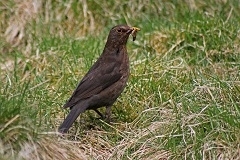 February saw the eighth annual Big Farmland Bird Count (BFBC) organised by the Game & Wildlife Conservation Trust, with record numbers of participants taking part across the UK.
February saw the eighth annual Big Farmland Bird Count (BFBC) organised by the Game & Wildlife Conservation Trust, with record numbers of participants taking part across the UK.
In Scotland, 117 farmers took part and recorded 93 species across more than 98,000 acres – a 45% increase in participation compared to last year!
The BFBC was launched in 2014 to highlight the positive work done by farmers and gamekeepers in helping to reverse the decline in farmland bird numbers. The count offers a simple means of recording the effect of any conservation work currently being instigated by farmers and gamekeepers on their land, such as scatter feeding birds through winter or growing crops specifically to provide seed for birds.
What did farmers see?
The most commonly seen species were blackbirds, seen by almost 90% of Scottish participants followed by robins. Pheasant, blue tit and woodpigeon were seen by 70% of the farmers taking part. Blackbirds were also the most commonly seen species last year.
A total of 19 species from the Red List for Birds of Conservation Concern were recorded, with starling, fieldfare, yellowhammer and song thrush appearing in the 25 most frequently seen species list. Starling, linnet, fieldfare, redwing and herring gull were the five most abundant red listed species recorded with over 6,400 total spotted which equates to more than 26% of all species spotted.
The five most abundant birds seen were woodpigeon, starling, linnet, chaffinch and rook. A total of over 10,600 were seen, making up over 43% of the total number of birds recorded.
Download graphs for data on ‘most commonly seen’ and ‘most abundant’ species.
Who took part?
The average farm size of those taking part was 837 acres with 53% of participants in some form of agri-environment scheme, demonstrating their long-term commitment to environmental management.
58% of participants were providing some form of extra seed feed for birds, either through growing wild bird seed mixes, or by providing additional grain through scatter feeding or via hoppers.
Where were participants from?
Farmers from 28 Scottish counties took part. Perthshire had the most returns, with 22 farmers completing the survey. This was followed by Aberdeenshire with 16.
Overall, Scottish support for the Big Farmland Bird Count increased by more than 45% compared to 2020, and a massive 125% increase from 2019 count levels.
Dr Dave Parish, Head of Lowland Research, Game and Wildlife Conservation Trust in Scotland, said: “This is great news – the highest turnout in terms of participants ever for the count in Scotland, and some encouraging data in terms of species seen and their abundance. These are important indicators and I’m hoping that this annual count will go from strength to strength.”
Overall across the UK participation in the count more than doubled. Dr Roger Draycott, who coordinates the national count for the GWCT, said: “We could not be more delighted with the response to this year’s GWCT Big Farmland Bird Count. Despite much of the country being blanketed in snow during the count (5-21 February) participation has shot up, with 2,500 counts returned, representing a 65% increase in the number of counts submitted compared to 2020, which was also a record year. The land area covered by the count has more than doubled to over a million hectares and 81% more birds have been counted this year by more than 700 additional volunteers.
“All of this helps us to build a detailed national picture of the state of Britain’s farmland birds, allowing us to better understand what is really going on in our countryside. It clearly shows that farmers, land managers and gamekeepers care for the land they work and, given that they look after 71% of all the land in the UK, that is extremely good news for the future of our treasured bird species.”